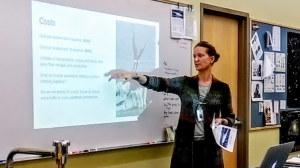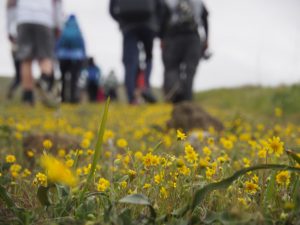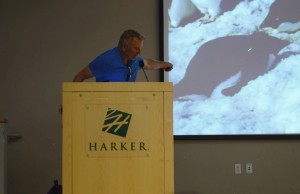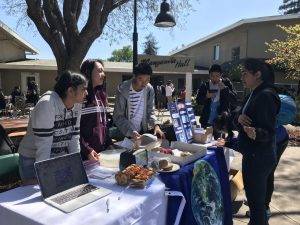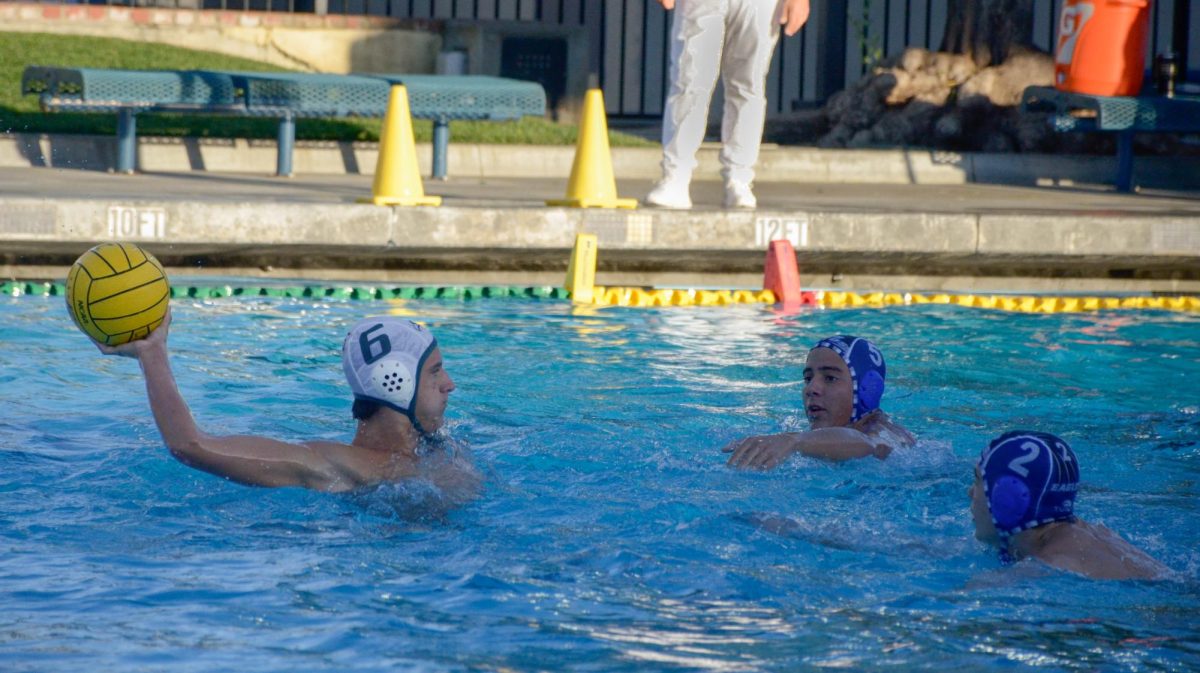From California to Alaska: Human ecology comes to life
Christopher Spenner
Participants in the “Human Ecology: Our Place in Nature” course watch tremendous volumes of water fall as a glacier melts. The students and faculty hiked down to the Mendenhall Glacier outside of Juneau as a part of their hands-on learning trip.
November 5, 2018
It was late June in North America, but Dr. Kate Schafer was dressed in brown rubber boots, windbreakers and knitted beanies. After trudging in muddy soil for hours, many on the trek were exhausted and soaked, but all was forgotten as a towering waterfall came into view. Torrential water poured downwards from mountains of rocks and trees: a true definition of the sublime.
These natural wonders are what make “Human Ecology: Our Place in Nature” a unique Harker summer program. Though it too has the basic structure of homework assignments, projects, and lectures, it also entails the true experience of hands-on, immersive learning that you wouldn’t receive at a regular high school science course. What’s more active than traveling to the place you’re studying?
The trip to Alaska is one half of a three-week Harker summer field course, “Human Ecology”, instructed by upper school science teachers Dr. Kate Schafer and Christopher Spenner. The course, open to rising sophomores, juniors and seniors, aims to expose students to human interactions with nature through guest speakers, field trips and a final project.
“The Inian Island Institute [in Southeast Alaska] is a really unique spot on the planet, where we get a chance to go out to an island that’s in the middle of the Tongass National Forest. And it’s just us, our Alaskan instructor and the caretakers on this island. There is nobody else there except creatures and wildlife that we encounter,” Dr. Schafer said.
The course entails traveling in California for the first half and in Alaska for the second half next summer from June 10 to July 3. Students will receive one semester credit for a science elective for taking the course, which costs around $6000-6500. Online applications are due on Nov. 5.
The program started as a course teaching climate change and its effects. As a broad topic that involves many different components, climate change became difficult to teach within a small period of time. The course encompassed interdisciplinary knowledge, such as economics, sociology, and psychology, engineering and verbal and written communications, which human ecology also shares. Human ecology, more appropriate to teach during a short-term course, became the topic of the current course.
“To me the most exciting things about the course is that student interests guide the course. We don’t get to do that enough in the classroom. We have set things that we talk about. Sometimes certainly class discussions are guided by student interest, but I love the opportunity to ride along with students and to learn based upon what the student interests are,” Dr. Schafer said.
There are four case studies that students can base their project topics off of: fishery, agriculture, forestry and energy. Students who completed this course two summers ago experienced different ways of approaching research.
“My project was on writing a short story about what I saw there and how it affected people. I learned a lot on different communities and people who lived in Alaska and how different people’s mindsets and lives could be—just because they didn’t live in a big urban city. I also learned a lot about the environment, what’s happening to it and what measures people are taking or can take to go against [climate change].” Amla Rashingkar (11), a student who took part in the course, said.
From meeting new people and their cultures to researching plankton populations, former human ecology students acquired more than scientific knowledge.
“I was able to interact with people I didn’t know more openly and more freely. In Gustavus, [Alaska], we met a lot of nice people. It is a small town with around 300 people. Everybody was really open and they even invited us to their houses, and they told us their stories. That really opened up my eyes to wanting to learn their stories,” Alex Shing (11), who participated in the program after his freshman year, said.


















![“[Building nerf blasters] became this outlet of creativity for me that hasn't been matched by anything else. The process [of] making a build complete to your desire is such a painstakingly difficult process, but I've had to learn from [the skills needed from] soldering to proper painting. There's so many different options for everything, if you think about it, it exists. The best part is [that] if it doesn't exist, you can build it yourself," Ishaan Parate said.](https://harkeraquila.com/wp-content/uploads/2022/08/DSC_8149-900x604.jpg)




![“When I came into high school, I was ready to be a follower. But DECA was a game changer for me. It helped me overcome my fear of public speaking, and it's played such a major role in who I've become today. To be able to successfully lead a chapter of 150 students, an officer team and be one of the upperclassmen I once really admired is something I'm [really] proud of,” Anvitha Tummala ('21) said.](https://harkeraquila.com/wp-content/uploads/2021/07/Screen-Shot-2021-07-25-at-9.50.05-AM-900x594.png)







![“I think getting up in the morning and having a sense of purpose [is exciting]. I think without a certain amount of drive, life is kind of obsolete and mundane, and I think having that every single day is what makes each day unique and kind of makes life exciting,” Neymika Jain (12) said.](https://harkeraquila.com/wp-content/uploads/2017/06/Screen-Shot-2017-06-03-at-4.54.16-PM.png)








![“My slogan is ‘slow feet, don’t eat, and I’m hungry.’ You need to run fast to get where you are–you aren't going to get those championships if you aren't fast,” Angel Cervantes (12) said. “I want to do well in school on my tests and in track and win championships for my team. I live by that, [and] I can do that anywhere: in the classroom or on the field.”](https://harkeraquila.com/wp-content/uploads/2018/06/DSC5146-900x601.jpg)
![“[Volleyball has] taught me how to fall correctly, and another thing it taught is that you don’t have to be the best at something to be good at it. If you just hit the ball in a smart way, then it still scores points and you’re good at it. You could be a background player and still make a much bigger impact on the team than you would think,” Anya Gert (’20) said.](https://harkeraquila.com/wp-content/uploads/2020/06/AnnaGert_JinTuan_HoHPhotoEdited-600x900.jpeg)

![“I'm not nearly there yet, but [my confidence has] definitely been getting better since I was pretty shy and timid coming into Harker my freshman year. I know that there's a lot of people that are really confident in what they do, and I really admire them. Everyone's so driven and that has really pushed me to kind of try to find my own place in high school and be more confident,” Alyssa Huang (’20) said.](https://harkeraquila.com/wp-content/uploads/2020/06/AlyssaHuang_EmilyChen_HoHPhoto-900x749.jpeg)





